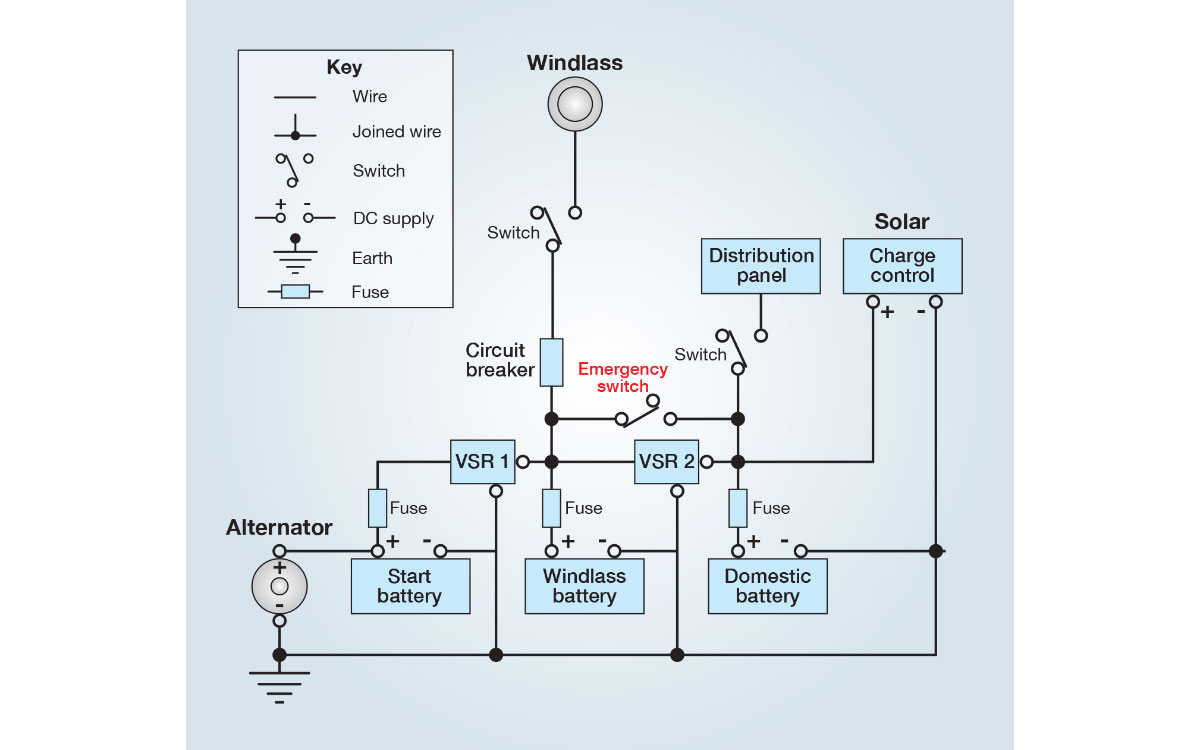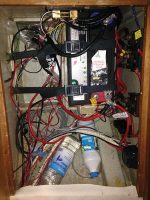PBO electrics expert Duncan Kent answers a multi-part battery installation query from reader Dan Haas
PBO Ask the Experts is a free service for readers. Simply email us your question and we’ll find an expert to answer it for you: pbo@ti-media.com
‘I’d like to add a windlass battery, to my 34ft Westerly Falcon, but due to space and weight limitations the most convenient location is 5m forward of the two domestic batteries and 2m from the windlass. I’m looking at buying three new 12V/120Ah AGM batteries. Charging is via a 100A engine alternator working through a Digital Voltage Sensitive Relay (DVSR) to prioritise charge to the starter battery. I am also considering adding a 310W/33.0V solar panel through a MPPT controller. I have five questions:
1. Will resistance of the 5m cable between the domestic bank and the windlass battery mean it won’t charge much until the other two are near full capacity?
Answer: Providing the cables are the same size as you’d use when directly wiring between the domestic and windlass batteries the difference in charge rates will be minimal. However, if the starter, domestics and windlass batteries are connected together in parallel they’ll all discharge simultaneously (albeit slightly unequally) when you run the windlass, unless they’re separated when the windlass is in use. If you choose to separate them with a relay, remember no power from the alternator will get through to the windlass when operating, which isn’t ideal.
2. Will the windlass battery ever reach full charge?
Answer: Yes, provided sufficient charge is supplied for long enough and the cables are correctly sized.
3. What cable size should I use for the 5m run from domestic bank to the windlass battery and on to the windlass?
Answer: Although in theory smaller diameter wire could be used exclusively for charging an isolated windlass battery, if all three are connected in parallel then the required power will be drawn from both the windlass and domestic batteries (assisted by the engine alternator if running). So, the current flowing through the adjoining cable will be the same as if it were coming directly from the domestics and should, therefore, be sized exactly as if you wired it directly from the domestic bank to the windlass. That would most likely be at least 50mm squared cross-section for a 1,000W windlass.
4. Should I fit a separate DVSR to prioritise the charging of the windlass battery over the domestics?
Answer: To prioritise the windlass battery for charging you would need to reconnect the existing VSR between the starter battery and windlass battery, isolating the domestics with a second VSR so that once the windlass battery is fully charged, continued charging will include the domestics.
If you should choose to carry out option 4 then I recommend you connect the output from the solar charge controller directly to the domestic bank and link the windlass to domestic batteries via a dual-sensing VSR so that any surplus charge from the solar will also feed into the windlass battery.
5. At what point should the output from the solar panel controller be connected to the batteries? I’d like the solar charge to go through the DVSR(s) but do I need a separate diode to prevent the alternator from pushing charge to the solar system or will the solar controller prevent mishap?
Answer: The charge controller will protect the solar panels from any other charging source.
Everyone has their own preferred way of setting up their boat. Some like mechanical switches, others just want it all to happen automatically in the background with no input from the skipper or crew. The latter is becoming the norm.
The method commonly used by production boatbuilders today is to simply connect the windlass to the domestic battery bank with heavy-duty cable and a high amperage circuit breaker. But there are alternatives (see below). Whatever you decide, you won’t be able to avoid installing a pair of very large, heavy cables for most of the length of the boat.

Wiring diagram for a three battery bank set-up: start battery, windlass battery and house battery (or batteries)
Alternative set-ups for charging domestic, starting and windlass battery banks
The most suitable type of battery for powering a windlass is an engine starter-type (cranking) battery with a high CCA (Cold Cranking Amps) rating, as their thin plates are specifically designed to provide high current for short periods. Yes, there are plenty of semi-traction batteries available that will perform reasonably as both domestic and starter batteries and even deep-cycle domestic batteries will start an engine, but they’re not designed to do so and using them for cranking – either engine or windlass – can shorten their life considerably.
As an alternative to the set-up you suggest above, you could buy a second, high CCA cranking battery and connect it to the existing engine start battery via a single-sensing VSR (i.e. one that senses the voltage of the starter battery only). Then connect this second battery directly and exclusively to the windlass using the recommended cable size and circuit protection for your windlass and cable.
If wired like this it will also draw power from the starter battery when operating, but only if the VSR is activated and this can only happen if the engine is running (a must for long anchor hauls), so it can never be flattened in the process. The moment the engine is switched off and the charge from the alternator disappears, the VSR link between the two will be deactivated.
How you then wish to charge the domestic bank is up to you, but if you directly link the thin-plate windlass battery to the heavy-duty domestic batteries it will discharge along with the domestics and possibly unbalance them. Better to use a second VSR, enabling the domestics to start receiving charge from the alternator once both the start and the windlass batteries have reached an acceptable level of charge.
With this set-up I’d then recommend you connect the output from the solar charge controller directly to the domestic banks with suitable circuit protection. For belt and braces you could also install an emergency paralleling switch between the domestic and windlass batteries in the unlikely event you run the latter flat.
Other options
You could simply replace the engine start battery with a larger (higher CCA capacity) and connect the windlass directly to it. If you do, then you will need to incorporate a relay between the two that is only activated when the engine is running, thereby making it impossible to run the starter battery down.
Or you could add a dedicated, high CCA battery close to the windlass and connect it to the domestic bank via a high-current VSR and large diameter cables. Remember, though, a VSR between starter and domestic will activate relatively quickly, but one between a high-capacity (in amp hours) domestic bank and the windlass battery could take much longer as the half-discharged domestic bank will take longer to reach the VSR’s activation threshold. For this reason, be sure to buy an adjustable VSR so you can set the threshold at the level you want.
Wiring
Apart from the downside of adding weight to the bows of the boat, you might think that installing a dedicated battery close to the windlass is the obvious answer and would allow you to use much smaller cables. However, the smaller the cables the higher the voltage drop, so this isn’t necessarily the solution.
If you simply run small cables from the domestic bank to the windlass battery to charge it, there’s a good chance it’ll run flat and then these thin cables will melt under the high current being drawn from the domestics to run the windlass. For this reason, the cables from the domestics to the windlass battery forward will need to be at least as thick as they would if directly wired – rendering the object of the exercise pointless!
For the same reason, any relay in the circuit must be able to safely handle the full surge (peak) current of the windlass.






